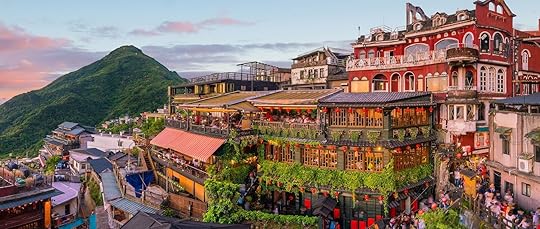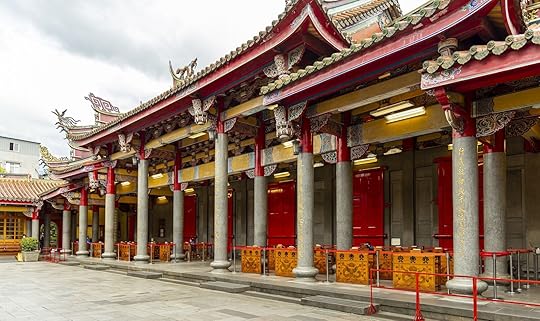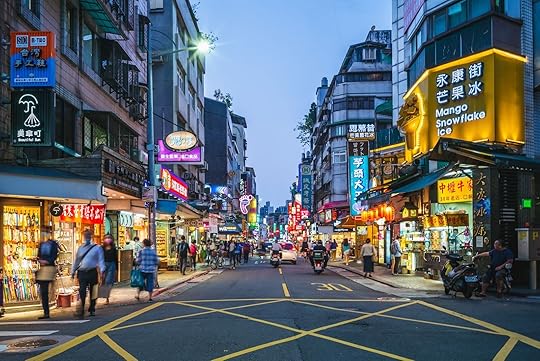Taipei: Where Ancient Temples and Tech Giants Thrive Side by Side

Taipei doesn’t rush to define itself. It’s both a global tech hub where 5G networks hum above centuries-old Taoist chants drifting from temple courtyards. The capital trades in microchips and meditation in equal measure. Beneath LED-lit towers and the circuitry of its semiconductor empire, traditions remain intact: slow, analog, often quiet. That coexistence gives the city its character. Unlike many urban centers with futuristic skylines, Taipei doesn’t conceal its past to make room for progress. It places the old beside the new, letting both breathe.
For travelers, Taipei offers a rare chance to live inside this duality. You taste it in a bowl of beef noodle soup followed by craft coffee, see it in century-old temples standing beside neon-lit towers, and feel it on a trek through the tea hills just beyond the skyline.
Where migrations shape a living city
Photo: Shawn.ccf /Shutterstock
Taipei’s identity has been shaped by layers of migration. Indigenous Austronesian communities lived here long before national borders existed. Han Chinese settlers arrived during the Ming and Qing dynasty in the 1600s, followed by the Japanese colonial period from 1895 to 1945, which continued and preserved hot spring bathhouses in Beitou, red-brick shophouses, and rail lines that still cross the city.
After 1949, Mandarin became the dominant language. Today, people in Taipei slide between Taiwanese Hokkien, Mandarin, and Hakka, with Japanese and English heard regularly in public life and in the city’s street food(tān wèi) stalls and markets. Religious beliefs are just as diverse, with Taoist temples, Buddhist monasteries, and Christian churches often within a few city blocks of each other. Taipei’s diversity is not a marketing tagline, it’s a structural condition.
Taken together, these layers make Taipei an ideal first stop in Asia that’s compact yet reveals how cultures converge and evolve side by side.
A tech hub with a human rhythm
Photo: f11photo /Shutterstock
Taipei is often defined by its technical prowess. Taiwan Semiconductor Manufacturing Company (TSMC), one of the world’s most valuable tech firms, maintains key offices and corporate operations in the city, the city plays a foundational role in the global electronics ecosystem. Smartphones, AI systems, and electric vehicles all rely on chips produced in or nearby Taipei. Yet what shapes Taipei’s atmosphere isn’t just what it builds — it’s the rhythm of how the city moves.
For all its innovation, Taipei moves at a humane pace. Trains arrive on time and commuters rarely jostle. Coffee shops stay open late, more often filled with readers and students than business people. You can ride the MRT to a hiking trailhead in 30 minutes, or walk from the Taipei International Convention Center (TICC) near TAIPEI 101 to a food tour, such as taro balls and hot and sour soup. That juxtaposition of circuitry and stillness is the kind of natural design that emerges only in a true global hub.
Rituals of calm in an engineered world
Photo courtesy Travel Taipei
Encircled by mountains and carved with rivers, natural escapes are always visible in Taipei: the green folds of Yangmingshan National Park’s dormant volcanos rise to the north, while the Taipei Basin stretches south. Taiwan is home to more than 100 natural hot springs sources, some of the easiest to reach are in Beitou, it takes about 40 minutes by MRT from Taipei Main Station to Xinbeitou. Beitou’s Japanese colonial-era bathhouses have largely modernized, but the ritual remains. Locals soak in sulfur pools beneath cypress beams, moving from hot to cold, then rest under fans with herbal tea. Here, soaking is thermal relaxation woven into everyday life as much as it is a luxury.
Calm takes other forms elsewhere in the city. In the mornings, tai chi groups gather in Daan Forest Park to practice their craft. Evening temple visits for offerings and incense are common in Taipei as a way to unwind after the day. One of the most visited is Xingtian Temple, built in 1967 and dedicated to Guan Gong, the deity of loyalty and business. It draws everyone from elderly devotees to young professionals, many of whom come not only to pray, but also to consult with fortune tellers in nearby arcades.
Fortune-telling in Taipei is less theatrical and more therapeutic than in the West. A session might blend palm reading with numerology and practical life advice. In a city that prizes systems — engineering, software, logistics — there is still room for the ineffable. For those navigating major decisions, it offers a non-digital form of clarity.
Neighborhoods best explored on foot
Photo: Richie Chan /Shutterstock
In a rarity for major cities, Taipei’s streets reward the unhurried. Some of the most compelling experiences come not from landmarks, but from walking without an agenda. Stroll with a notebook or sketchpad in hand, a little cash in your pocket, and leave room for detours — whether that’s a street vendor snack or a spontaneous stop for a cold Taiwan Beer.
On Dihua Street (Dadaocheng) in Taipei’s Old Town, 19th-century warehouses and trading houses now function as boutiques, design studios, and tea houses. Lin Mao Sen Tea Company, founded in 1883, continues to operate here. Staff pour tastings of high-mountain oolong and baozhong tea on its long wooden counters. Just a short walk away, bars mix highballs with smoked lapsang souchong, creating distinctly Taiwanese craft cocktails. Other streets, like Yongkang Street and Fujin Street, blend Japanese minimalism with Taiwanese functional aesthetics, their cafés, bookshops, and galleries speaking a design language that feels global without being generic. Across these neighborhoods, the aesthetic leans understated. Taipei doesn’t seek to impress with extravagance; it invites people to slowly experience and understand it.
A city built for access and ease
Photo: Richie Chan /Shutterstock
Part of Taipei’s approachability lies in its infrastructure. The MRT is inexpensive, efficient, and remarkably clean (eating and drinking are prohibited inside stations). Signage is in Mandarin and English. Free public Wi-Fi is common. Taxis run on meters, no bargaining required, and most businesses accept cards or and mobile payment. For a first-time visitor, the barrier to entry is low.
What keeps it authentic, though, is how little it performs for outsiders. The night markets — Raohe, Ningxia, Shilin — aren’t stage sets, but working economies where residents line up for pepper buns and crispy fried chicken cutlets. Temples double as civic centers, posting calendars for festivals, rites, and community classes. That lack of pretense opens the door to a deeper kind of travel that invites longer stays and repeat visits. In short, Taipei respects the intelligence of the traveler.
Taipei’s modernity is often misunderstood by those expecting chrome skylines or curated shopping districts. The city’s actual innovation is more subtle: the way complexity is absorbed into daily life without friction, engineering comfort without excess. Technology here allows more room for human connection, whether that means soaking in a hot spring, wandering heritage lanes, or lingering in a tea house where conversation drifts as slowly as steam from the kettle. While many cities compete for attention through vertical spectacle, Taipei remains horizontal in spirit. Its story doesn’t shout. But it’s worth listening to in person to truly understand. 
Matador Network's Blog
- Matador Network's profile
- 6 followers



